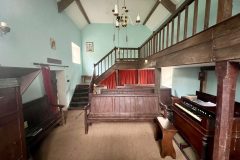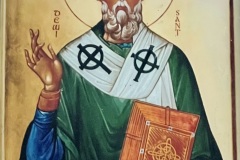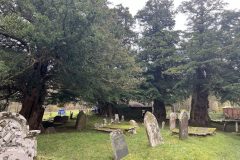
‘…the old chapel short stout and boxy with its little bell turret (the whole building reminded one of an owl)..’ Kilvert’s Diary, 5 April 1870.
Built in 1762 on an older site of worship and pilgrimage, a 15th century church that had fallen into ruins, ‘Little’ S. Mary’s is situated in the quiet hamlet of Capel-y-Ffin, the Welsh name translating as ‘Chapel at the border’. The hamlet is reached – from Hay Bluff and the Twmpa – by following Gospel Pass, a narrow, winding country road, often impassable in winter.
Inside, the chapel has space for just twenty or so worshippers. The floor is stone with wooden pews, a gallery, and a pulpit dating from 1780. The font is probably medieval and from an earlier building.
Capel-y-Ffin has been a site of inspiration for writers and artists for many years. Dorothy and William Wordsworth described it as one of their favourite places. The ‘beat’ poet Alan Ginsberg, author Bruce Chatwin, and the artist Eric Ravilious stayed locally and would doubtless have visited the chapel.
Eric Gill, sculptor, printmaker and typeface designer founded an artistic colony nearby. He carved two of the surviving headstones in the chapel graveyard.
An east-facing window is inscribed with the words from Psalm 121: ‘I will lift up mine eyes unto the hills, whence cometh my salvation’. A fitting quotation given the wonderful valley and hills in which the chapel stands.
For times of services at ‘Little’ S. Mary’s’, see the ‘Calendar of Services’ on this website.
























